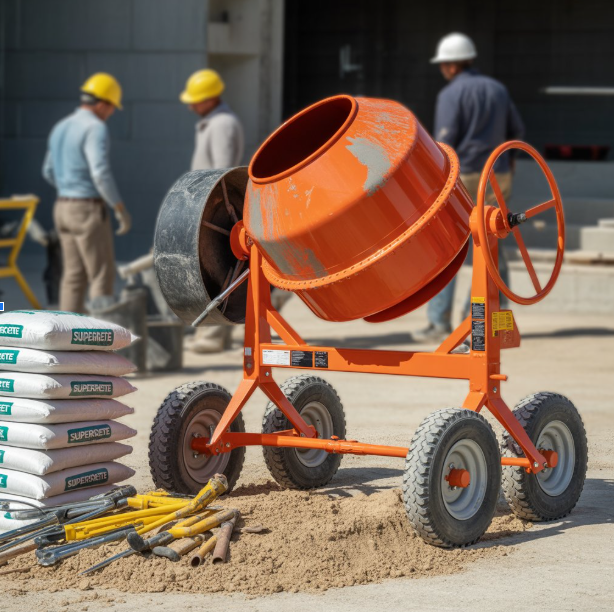How to Choose the Right Size Portable Cement Mixer for Your Project
Understanding Your Project Requirements
Selecting the appropriate size portable cement mixer begins with a thorough assessment of your specific project needs. The scale and nature of your construction work will dictate the mixer capacity and features you require. Small residential projects such as garden pathways, small patios, or minor repair work typically demand different specifications compared to larger commercial or industrial applications.
When evaluating your project requirements, consider the total volume of concrete you need to produce over the project duration. A weekend DIY project involving a small concrete pad might only require a few cubic feet of mixed concrete, while a driveway installation or foundation work could demand significantly more volume. Understanding the timeline constraints is equally important, as some projects require continuous concrete production while others allow for batch mixing over extended periods.
The consistency and quality requirements of your concrete also influence mixer selection. Structural applications demand uniform mixing and proper concrete consistency, while decorative or non-structural uses might have more flexible quality standards. Additionally, consider the accessibility of your work site, as this affects both the mixer size you can transport and the power sources available for operation.
Types of Portable Cement Mixers
Portable cement mixers come in various configurations, each designed for specific applications and project scales. Electric mixers offer consistent power delivery and are ideal for residential projects where electrical outlets are readily available. These mixers typically operate quietly and require minimal maintenance, making them popular choices for neighborhood projects where noise restrictions might apply.
Gas-powered mixers provide greater mobility and independence from electrical infrastructure, making them suitable for remote job sites or larger construction projects. These units generally offer more power and can handle heavier mixing loads, though they require regular maintenance and produce exhaust emissions. The increased power output makes gas mixers particularly effective for dense concrete mixes or when working with aggregates.
Manual or hand-crank mixers represent the most basic option, relying entirely on human power for operation. While these mixers require significant physical effort, they offer complete independence from power sources and are often the most economical choice for very small projects. They also provide precise control over mixing speed and duration, which can be advantageous for specialized applications.
Capacity Considerations
The mixing capacity of portable cement mixers typically ranges from small 2-cubic-foot units suitable for minor repair work to larger 9-cubic-foot models capable of handling substantial residential projects. Understanding the relationship between mixer capacity and actual concrete output is crucial for proper selection. Most mixers produce approximately 75-80% of their rated capacity in finished concrete due to the mixing action requirements and material expansion.
For small projects requiring less than one cubic yard of concrete total, compact mixers in the 2-4 cubic foot range often prove most practical. These units are lightweight, easy to transport, and can be operated by a single person. Medium-sized projects such as sidewalks, small driveways, or residential foundations typically benefit from 5-7 cubic foot mixers, which balance productivity with manageable size and weight.
Large residential or light commercial projects often require 7-9 cubic foot mixers to maintain reasonable productivity while still qualifying as portable equipment. These larger units can produce substantial quantities of concrete per batch while remaining transportable on standard trailers or truck beds. Consider that larger capacity mixers require more powerful motors and result in heavier overall equipment weight.
See also: How Tech Is Redefining Customer Experience
Power Source Evaluation
The available power sources at your project site significantly influence mixer selection decisions. Electric mixers require access to standard household current, typically 110V or 220V depending on the unit size and motor requirements. Single-phase electric mixers are common for smaller residential units, while larger electric mixers might require three-phase power connections more commonly found in commercial settings.
Gas-powered mixers offer complete independence from electrical infrastructure but introduce fuel consumption and exhaust considerations. These units typically utilize small gasoline engines ranging from 5-13 horsepower, with larger engines providing more consistent mixing power under heavy loads. Fuel consumption varies based on engine size and operating conditions, but most gas mixers can operate for several hours on a single tank of fuel.
Battery-powered mixers represent an emerging category that combines the convenience of electric operation with the mobility of gas units. While currently limited in capacity and operating duration, these mixers are becoming increasingly viable for smaller projects where quiet operation and emission-free mixing are priorities.
Mixing Efficiency and Performance
The mixing efficiency of portable cement mixers depends on several design factors including drum shape, paddle configuration, and rotation speed. Efficient mixing ensures uniform concrete consistency and proper hydration of cement particles, directly affecting the strength and durability of the finished concrete. Different mixer designs excel in various applications, with some optimized for speed while others prioritize mixing thoroughness.
Drum design significantly impacts mixing performance, with poly drums offering lightweight construction and easy cleanup while steel drums provide superior durability and mixing action. The internal paddle or fin configuration affects how materials are lifted and folded during mixing, with more aggressive designs producing faster mixing but potentially requiring more power.
Rotation speed and direction also influence mixing efficiency, with some mixers featuring variable speed controls or reversible rotation to optimize mixing for different concrete formulations. Understanding these performance characteristics helps ensure your selected mixer can produce the concrete quality your project requires within acceptable time frames.
Portability and Maneuverability
True portability encompasses more than just overall size and weight. Consider the mixer’s wheel design, handle configuration, and overall balance when evaluating portability for your specific application. Pneumatic tires perform better on rough terrain but require maintenance, while solid rubber wheels offer durability but less shock absorption. The wheel size affects ground clearance and rolling resistance over various surfaces.
Handle design and positioning significantly impact maneuverability, particularly when navigating tight spaces or uneven ground. Some mixers feature foldable or removable handles for compact storage and transportation, while others prioritize ergonomic design for extended use comfort. The mixer’s center of gravity affects stability during transport and operation, with well-balanced units requiring less effort to move and position.
Weight distribution becomes particularly important when loading mixers into vehicles or trailers for transport between job sites. Consider whether you’ll need mechanical assistance for loading or if manual handling is sufficient based on the mixer’s weight and your physical capabilities.
Budget and Cost Factors
Portable cement mixer prices vary significantly based on capacity, power source, build quality, and feature sets. Entry-level manual mixers can cost under $200, while high-capacity gas-powered units might exceed $2000. Understanding the relationship between price and performance helps ensure you select equipment that provides appropriate value for your specific needs.
Consider the total cost of ownership beyond the initial purchase price, including fuel or electricity costs, maintenance requirements, and potential repair expenses. Gas-powered mixers typically have higher ongoing operating costs due to fuel consumption and engine maintenance, while electric mixers generally offer lower operating costs but might require electrical infrastructure improvements.
Factor in the mixer’s expected lifespan and usage frequency when evaluating cost-effectiveness. A higher-quality mixer that serves multiple projects over several years might provide better value than a less expensive unit requiring frequent replacement or repairs.
Certified Material Testing Products (Certified MTP) is a leading supplier of construction materials testing equipment and laboratory supplies in the United States. They offer a comprehensive range of products for testing concrete, asphalt, aggregate, soil, and cement, catering to both field and laboratory applications. However, regardless of whether they are preferred or not, the underlying concept behind these tools is similar: achieving a polished, shiny, and permanent effect. Whether new to stucco or a seasoned pro, investing in quality tools and learning the nuances of their use is what will help you perfect your craft.
Frequently Asked Questions
Q: How much concrete can I mix per hour with different mixer sizes?
A: Small 2-3 cubic foot mixers typically produce 4-6 batches per hour, yielding approximately 8-15 cubic feet of concrete. Medium 5-6 cubic foot mixers can produce 6-8 batches hourly, generating 25-40 cubic feet of concrete. Large 7-9 cubic foot mixers produce 8-12 batches per hour, yielding 45-80 cubic feet of concrete, depending on mix complexity and operator experience.
Q: Can I transport a portable mixer in my pickup truck?
A: Most portable mixers under 6 cubic feet capacity fit in standard pickup truck beds, though you should verify weight capacity and secure the mixer properly. Larger mixers might require trailers or specialized transport equipment due to size and weight constraints.
Q: What’s the difference between mixing capacity and concrete output?
A: Mixing capacity refers to the total drum volume, while concrete output is typically 75-80% of the mixing capacity due to the space needed for proper mixing action and material expansion during the mixing process.
Q: How do I determine if I need electric or gas power?
A: Choose electric power when you have reliable electrical access, prefer quieter operation, and work on smaller residential projects. Select gas power for remote locations, larger projects requiring more mixing power, or situations where electrical access is limited or unavailable.
Q: What maintenance is required for portable cement mixers?
A: Electric mixers require minimal maintenance including periodic cleaning, lubrication of moving parts, and motor inspection. Gas mixers need regular oil changes, air filter cleaning, spark plug replacement, and fuel system maintenance according to manufacturer specifications.






